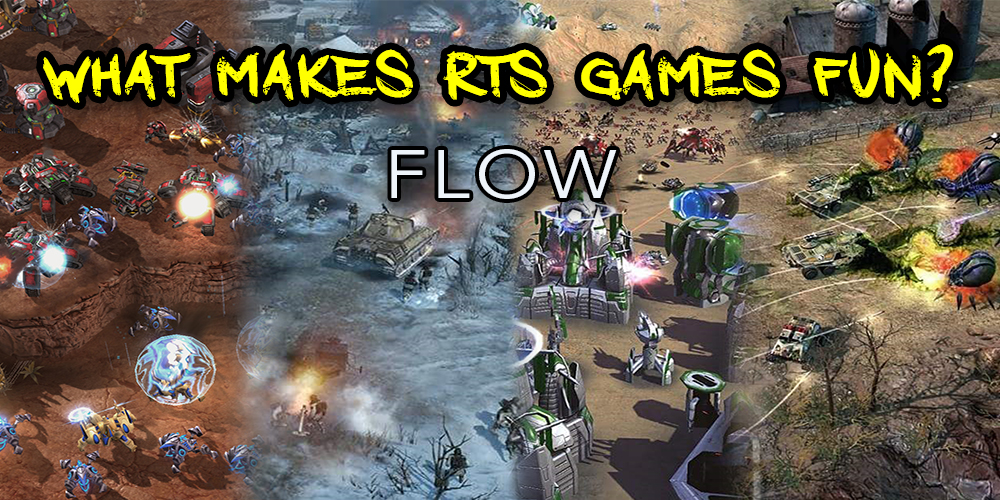
For a RTS game to maintain an engaging and exciting gameplay, it needs to properly flow. This refers to the gameplay elements and mechanics that incentivise and dictate the interaction between each player. Any RTS game has potential for continuous action, but it won’t be reached unless there are objectives to contest and vulnerabilities of your enemies to exploit.
An objective is something the players fight over in order to give them an advantage. This can be a number of things including additional resources, vision and scouting, territorial advantages such as choke points or garrisons as well as win conditions such as victory points in Company of Heroes. An objective doesn’t have to be neutral, in many cases they are linked to a factions design. The GLA Tunnel Networks of Command and Conquer Generals or the Creep spread of StarCraft II grant their faction mobility but can be easily denied by their opponents. These objectives force the players to compete against each other, creating an active and aggressive game play.

The other crucial part of developing flow is creating vulnerabilities that allow players to punish their opponents. A vulnerability can refer to a weakness in tech or army composition, such as not enough anti-infantry or stealth detection mixed in. Not only does this urge a player to attack if they have the advantage, it also incentivises scouting of both the opponents tech structures and army composition. This also then creates the dynamic of counter-scouting, which can lead to a lot of smaller skirmishes. Other types of vulnerabilities include weaknesses in a player’s base or positioning which opens up harassment of their exposed economy, infrastructure or army. There’s also timing, if a player has invested a large amount into teching or strengthening their economy, their army might be lacking compared to their opponents which creates a window of opportunity to punish them for their investment.
At a more basic level, there’s a few fundamental components that need to be designed properly: It’s vital that the maps are correctly sized, combat lethality can’t be too high and units need to have enough sight radius and mobility. As well as this, expanding should be very accessible, but economy and structures should be weak enough to make harassment viable and scouting should always be possible but deniable (such as scouting units instead of a radar scan ability). Perhaps most frustratingly, pathing shouldn’t clump units in a way that forces players to constantly babysit their moving units. I’m looking at you, Act of Aggression and your bloody roads.

Mechanics and design elements that grant too much of a defenders advantage will really slow things down. The most classic example is the ramp system in StarCraft. Whilst it is necessary for the overall faction balance, it renders early action and harassing the main base practically impossible. Even the second bases are safely secured behind a choke point that encompasses the main base directly next to it, so it’s rare to see actual combat before 10 minutes. StarCraft II gets away with it because it has so much strategic, production and economic depth, but most RTS games will fail if they copy a similar design.
Another common example that really cripples the flow is where base defenses cannot be countered efficiently without the use of high tier artillery. A better way to implement base defenses is to have them only effective against certain unit types, so it can be countered by mixing in other units, or alternatively always making a low tier artillery unit available. The player should always feel as if they have the ability and the tools at their disposal to be proactive and respond to any threat that may arise. It’s a bad idea to force a player to sit back and wait a few minutes to tech up and eventually build some drop ships or artillery units. It’s frustrating and tedious and detracts from making the player feel empowered.

Even worse, there are situations that actually punish a player for being aggressive. In Act of Aggression (bit ironic) there’s a mechanic involving pilots from destroyed vehicles that can be either rescued or captured for a return of resources. The problem is, even if an attack was successful, the pilots could return your opponent more resources than what they lost from the harassment. It became too risky to harass or engage near your enemy’s base and as a result it could cause long slow stalemates because players are afraid of fighting in enemy territory.
Now don’t get me wrong, it’s not all about being aggressive. Defensive tactics is a valuable part of RTS strategy so it’s essential to have them viable, but there always needs to be ways to counter it in an active manner. For example garrisoned structures in Command and Conquer can be easily cleared with Flame Tanks or in Company of Heroes machine guns teams and bunkers can be flanked. These are brilliant examples because it creates a very immediate point of contention; the defending player will try to focus down the Flame Tank whilst the other play will try to protect it.

Proper flow isn’t just about giving the players things to do, it’s designing a game in a way to encourage conflict and interaction. If there’s no flow then the game gets stale and repetitive, whereas reactionary counter play creates variation which keeps each match feeling fresh and unique. The objectives and vulnerabilities is also a vital part of strategic depth by adding in lots of opportunity costs and decision making. Though it does have to all be balanced out carefully, if a game is too fast paced and cutthroat it can be very stressful and off-putting for newer or casual players. Otherwise if the game is too slow paced and doesn’t flow well, then the game is going to fail to engage and retain its player base.











